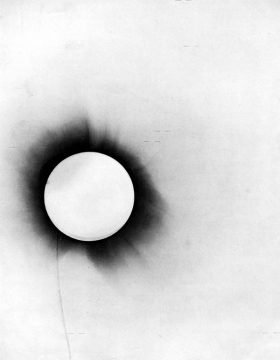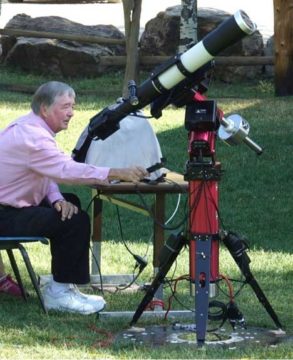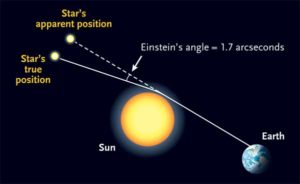
Wikimedia / Dyson et al. 1920
In the August 2016 issue of Sky & Telescope, I explained that I was going to set up an experiment to measure the gravitational deflection of stars one year later. I did go to Wyoming for the Great American Eclipse, and I experienced perfect conditions that led to an incredibly precise result! This is the first time — since Sir Arthur Eddington traveled to Africa to witness the 1919 eclipse — that the experiment went just as planned, with no weather or equipment problems. While there is no new science in this result, being able to accomplish this very difficult experiment for the first time in nearly 100 years was a wonderful experience.
In 1915 Albert Einstein predicted that the Sun will deflect the starlight passing near it. According to his theory of general relativity, gravity warps spacetime itself, which bends the path of massless photons. So stars very near the Sun’s disk will appear in slightly different positions than if the Sun weren’t there. Of course, we can’t normally see this, as the Sun is too bright, but a total solar eclipse provides the perfect opportunity for a test.
Surprisingly, though, such tests haven't been attempted very often. I began my preparations two years before the 2017 eclipse, after I found out that no one had attempted the experiment since 1973, back when they still used glass photographic plates. Modern technology, I assumed, would make the experiment much easier. I was wrong! While I didn’t have to worry about precise star positions (modern star catalogs took care of that) or transporting equipment to a remote continent (I was able to drive to my site on Casper Mountain), I still had to worry about things like exposure times and good weather. And, since the eclipse only lasted 148 seconds, there was no time to correct any last-second errors.
Just for this experiment, the manufacturers graciously loaned me a Tele Vue NP101is apochromatic refractor, a Finger Lakes ML-8051 CCD camera, and a Bisque MyT Paramount field tripod. I already owned a MyT mount. I, with help from my cousin Steve Lang, chose to set up a week early at the Lions Camp near Casper because of the high altitude and prospect of clear skies. The nice lodging and meals provided on site were a definite bonus! On eclipse day, the place hosted visitors from around the world, from England to Latvia, from New York to Texas. We all thoroughly enjoyed the eclipse in clear skies and celebrated together after totality.

Steve Lang
The key to success in this experiment was to plan ahead and practice — something every amateur astronomer already knows to do when attempting to image a transient event. I did everything I could ahead of time, including verifying electrical power when the lights were turned off during totality, to bolting the tripod legs to a concrete base so the polar alignment would not accidentally change. My site was in a grassy field surrounded by tall trees, and there was no wind at all. For Wyoming, this was rather unusual! The eclipse mosaic covering the base features the sun, inner corona, and stars.
I followed a detailed checklist, too. For example: “Remove solar filter.” I didn’t want to forget anything in the excitement leading up to totality. During the experiment, I had the software play a chime after each exposure. Hearing this every few seconds was comforting, and allowed me to view the corona with my binoculars and enjoy the spectacle with family and new friends.
I started all the detailed processing back home in San Diego. I had a weather station set up to record temperature, pressure, and humidity, so I could correct for atmospheric refraction. On two nights before the eclipse, I was able to perform a good polar alignment and take calibration images. I left the telescope and camera set up un-touched for four days. A little guard fence was set up around it, and since all of the visitors knew what I was doing, they left it alone. In fact, there were a few other telescopes set up early around the Camp, and no one had any problems.
Looking at the images, I could see all the stars that I was hoping for, plus a lot more. Using modern software helped me complete all of the analysis in just a few months. I decided ahead of time that I was going to follow a certain procedure, and would not go back to delete stars or add stars in order to get a better result. I used only stars that gave good signals and were not distorted by the corona or neighboring stars. I used both MaxIm DL and Astrometrica software to measure the precise positions of the star image. They use different methods to do the calculations, and because I had no reason to prefer one over the other, I planned from the beginning to calculate the results from both software programs and then average the two numbers. This led to an amazingly accurate result.

S&T: Leah Tiscione; source: Donald Bruns
The deflection caused by the Sun’s gravity decreases as the distance from the Sun’s center, mathematically as 1.75 arcseconds divided by the distance in solar radii. I used calibration images taken during totality to help in the analysis. For these, the telescope was pointed about 7° from the sun, where the gravitational deflection was very small. This is something that many of the previous eclipse expeditions had attempted, but kept having problems with. The computerized mount with the automatic scripting worked perfectly, giving me the calibration images that I needed (and that 20th-century astronomers had always wished for).
Earlier attempts had tried to prove Einstein’s General Theory of Relativity by calculating how far the Sun had deflected starlight around it. Relativity gives a value of 1.75 arcseconds. But past results weren’t very good, averaging 1.9 arcseconds and ranging from 1.2 to 2.7 for the various eclipses. My results were looking so good that I needed to calculate the theoretical value to a few more decimal places: 1.7512 arcseconds to be exact. An even more precise theoretical value is not possible, because scientists don’t know the gravitational constant any more accurately.
After careful analysis of my eclipse images, my final deflection constant measured exactly 1.7512 arcseconds. A perfect conclusion to a perfect eclipse! Granted, it’s coincidental that my final number landed exactly on the correct value, but it is still reason to celebrate. My uncertainty is about 3%, the best precision ever achieved by a wide margin. The results are available in a more technical format as a paper submitted to the journal Classical and Quantum Gravity. There are three longer eclipses in the next 10 years, and I hope other amateur astronomers will experience the same excitement!
By coincidence, the best-ever optical measurements of the gravitational deflection of starlight came only four days after LIGO detected the first gravitational-wave signal from a collision of two neutron stars, a result that led to the Nobel Prize. The equations of relativity predicted both of these outcomes. All in all, August 2017 was a good month for Einstein!
 10
10









Comments
Rod
February 16, 2018 at 3:39 pm
Great report here, thanks. I have my trusty book, Relativity The Special and the General Theory by Albert Einstein and the math is in it too, page 127, 1961 copy. I learned much by studying this text.
You must be logged in to post a comment.
Joe Adlhoch
February 16, 2018 at 5:18 pm
Fantastic! I briefly thought about doing this myself, but realized I probably didn't have the all of the equipment to do it properly (or, frankly, the time to practice and set up as you did). Instead I watched the eclipse from Fort Laramie, WY, with my naked eyes.
You must be logged in to post a comment.
Jeff-Goldstein
February 16, 2018 at 6:20 pm
Outstanding analysis and result.
I could not get the jpg file of any stars closer than Regulus. This resulted in very poor deflection.
May I get a copy of your picture file you used? [email protected]
Thank you so much!
Jeff
You must be logged in to post a comment.
Donald BrunsPost Author
February 16, 2018 at 10:02 pm
I sent a private e-mail to you, if you want to pick which image you want.
You must be logged in to post a comment.
tomwys
February 16, 2018 at 6:55 pm
An effort bordering on brilliance! Einstein had the fortune of having the Sun embedded within the Hyades star cluster during the eclipse - Bruns had an intriguingly different task, and he did so beautifully.
Three of my NASA colleagues and I lectured in Cody, Wyoming, the day before the eclipse, and mentioned the (many) difficulties of using Regulus as a target. We then dispersed all over the state to view the event the following day - a neat experience but Donald Bruns "eclipsed" all of us with his intrepid work!!!
You must be logged in to post a comment.
Donald BrunsPost Author
February 16, 2018 at 10:03 pm
Thank you. I will be giving more details in a talk at NEAF in April. If you can, please listen in!
You must be logged in to post a comment.
Marshall Eubanks
February 16, 2018 at 9:46 pm
I have to say that I am very impressed and and congratulate you. I have been part of teams that determined this bending (or the closely related Shapiro effect time delay) with Viking Mars and with Very Long Baseline Interferometry, so I know how hard it is to get this right.
However, an even more precise theoretical value is certainly possible, because the gravitational constant (G) doesn't enter in by itself, but only in connection with the product with the mass, GM, which is exactly the product determined by observations of planetary motions. That is good, because modern techniques can determine the bending to 0.03%, and we certainly hope to do better in the future.
You must be logged in to post a comment.
Donald BrunsPost Author
February 16, 2018 at 10:05 pm
Thank you for the additional insight. I am an experimentalist, not a theorist! I did not consider the product of the two constants, but am happy I got pretty close to the theoretical value.
You must be logged in to post a comment.
RC Silk
February 17, 2018 at 1:26 pm
The best application of Einstein's theories? That scientists will line up to prove (and re-prove) it for years to come! 🙂 A less sophisticated but identical prediction: non-scientists will line up annually to see if a Marmota monax will witness his umbral projection every February 2nd. 🙂
You must be logged in to post a comment.
RC Silk
February 17, 2018 at 1:27 pm
(But yes, I enjoyed the story, and thank you very much for your contributions!)
You must be logged in to post a comment.
You must be logged in to post a comment.